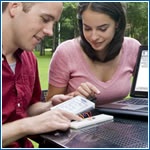STEM | News
National Instruments Device Lets Engineering Students Dink Around
- By Dian Schaffhauser
- 09/13/10

myDAQ is a USB-based portable unit that allows students to experiment with circuits. |
A new sub-$200 device from National Instruments allows engineering students to experiment with circuitry. myDAQ is a portable unit that weighs about six ounces and plugs into a computer through a USB port. It lets students "play around with real circuits, change tolerances on components, and take a wire out to see what effect that has on behaviors," according to one professor who has introduced the tool into his program.
"Students need exposure to real circuits and hardware, but the problem for engineering professors is trying to meet the increasing cost of providing real electronics with continually tighter budgets," said Tony Ambler, chairman of electrical and computer engineering at the University of Texas at Austin. "myDAQ is inexpensive enough for every student to have their own, plug it into their laptop at home, in the dorm, or in the park, and experiment with the real electronics all around them, without using lab time or lab equipment."
The device is designed by National Instruments and features Texas Instruments analog circuits, including data converters, amplifiers, and interface and power management components. The hardware runs National Instruments' LabVIEW graphical development software, which provides a digital multimeter, oscilloscope, function generator, Bode analyzer, dynamic signal analyzer, arbitrary waveform generator, digital reader, and digital writer.
Previously, "we were constrained by cost. Now we can have students playing around with things in their own time," added Ambler. "They can have a much better and deeper understanding of circuit behavior."
Currently, besides U Texas Austin, the company also claims the University of California, Berkeley and Kansas State University, among others, as customers.
About the Author
Dian Schaffhauser is a former senior contributing editor for 1105 Media's education publications THE Journal, Campus Technology and Spaces4Learning.

